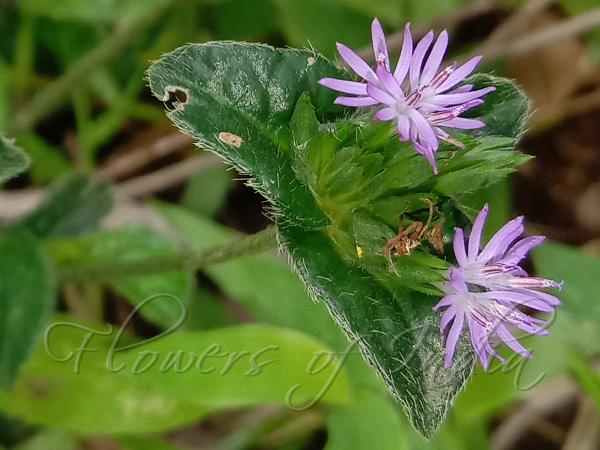|
| Elephant Foot |
|

|

| File size | 235802 |
| Original date | |
| Resolution | x |
| Flash | Flash fired |
| Focal length | 3.65mm |
| Exposure time | 1/172s |
| Aperture | 2.2 |
| Focus Distance | |
| Metering Mode | $meteringMode |
| Camera make | vivo |
| Camera model | vivo 1902 |
| Sensor type |
|
|
|
Photo: |
Botanical name: Elephantopus scaber Family: Asteraceae (Sunflower family)
Synonyms: Scabiosa cochinchinensis, Asterocephalus cochinchinensis
Synonyms: Scabiosa cochinchinensis, Asterocephalus cochinchinensis
Elephant Foot is a rather coarse, rigid, erect, hairy herb 30 to 60 cm
high. Stems forked, and stiff. Leaves are mostly in basal rosette and
oblong-ovate to oblong-lancelike, 10-25 cm in length and often very much
notched on the margins. Those on the stem few and much smaller. Purple
flowers are 8-10 mm long. Each head comprises about 4 flowers. Flowering
heads borne in clusters at the end of the branches and usually enclosed by
3 leaf-like bracts which are ovate to oblong-ovate, 1 to 1.5 cm long, and
heart-shaped at the base. The flowering heads many-crowded in each cluster.
Fruits are achenes, ribbed. Pappus from 4 to 6 mm long with rigid ristles.
Medicinal uses: Roots and leaves are used as emollient for
dysuria, diarrhoea, dysentery, swellings and stomach pain. Root is
prescribed to prevent vomiting. Powdered with pepper it is applied for
tooth-ache. Leaves are used in applications for eczema and ulcers.
Roots and leaves are used as emollient for
dysuria, diarrhoea, dysentery, swellings and stomach pain. Root is
prescribed to prevent vomiting. Powdered with pepper it is applied for
tooth-ache. Leaves are used in applications for eczema and ulcers.
Medicinal uses:
 Roots and leaves are used as emollient for
dysuria, diarrhoea, dysentery, swellings and stomach pain. Root is
prescribed to prevent vomiting. Powdered with pepper it is applied for
tooth-ache. Leaves are used in applications for eczema and ulcers.
Roots and leaves are used as emollient for
dysuria, diarrhoea, dysentery, swellings and stomach pain. Root is
prescribed to prevent vomiting. Powdered with pepper it is applied for
tooth-ache. Leaves are used in applications for eczema and ulcers.| Identification credit: Nongthombam Ullysess | Photographed in Kerala & Manipur. |
• Is this flower misidentified? If yes,